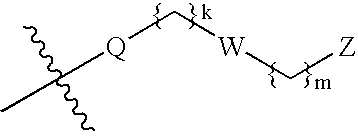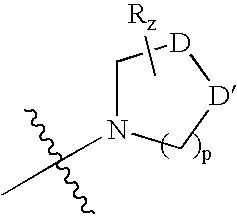Fused pyrrolecarboxamides: GABA brain receptor ligands
a gaba brain receptor and ligand technology, applied in the field of fused pyrrolecarboxamides, can solve the problems of compounding often exhibiting a number of unwanted side effects
- Summary
- Abstract
- Description
- Claims
- Application Information
AI Technical Summary
Benefits of technology
Problems solved by technology
Method used
Image
Examples
example 1
Preparation of Starting Materials and Intermediates
The starting materials and various intermediates may be obtained from commercial sources, prepared from commercially available organic compounds, or prepared using well known synthetic methods.
Representative examples of methods for preparing intermediates of the invention are set forth below.
1. 4-oxo-4,5,6,7-tetrahydrobenzofuran-3-carboxylic Acid
4-Oxo-4,5,6,7-tetrahydrobenzofuran-3-carboxylic acid is prepared according to the following procedure. Potassium hydroxide (345 g, 6.15 mol) is dissolved in methyl alcohol (1.2 L) then cooled in an ice water bath. A solution of cyclohexanedione (714 g, 6.15 mol) in methyl alcohol (1.2 L), dissolved using gentle heat, is added dropwise to the cold, stirred KOH solution over 2 h. A solution of ethyl bromopyruvate (1200 g, 6.15 mol) in methyl alcohol (1.5 L) is then added dropwise over 3 h. The reaction mixture is allowed to reach ambient temperature and stirred an additional 14.5 h. ...
example 2
To a stirred solution of 4-oxo-4,5,6,7-tetrahydro-1H-indole-3-carboxylic acid (100 mg, 0.6 mmol) and triethylamine (0.15 mL, 1.1 mmol) in N,N-dimethylformamide (5 mL) at 0° C. is added ethyl chloroformate (0.1 mL, 1.1 mmol). After stirring an additional 1 hour, 3-(N-trifluoroacetyl-(methylaminomethyl)aniline (0.3 g, 1.3 mmol) is added. The reaction mixture is stirred for 4 hours, then poured into saturated aqueous ammonium chloride and extracted 2× with ethyl acetate. The combined organic layers are washed sequentially with brine, aqueous 2N hydrochloric acid, then brine, dried over sodium sulfate, filtered, and concentrated in vacuo. To the residue is added 15% aqueous potassium bicarbonate (5 mL) and methyl alcohol (3 mL), then heated at reflux for 3 hours. After cooling, the reaction mixture is extracted with ethyl acetate, the organic layer dried over sodium sulfate, filtered, and concentrated in vacuo to give N-[3-(methylaminomethyl)phenyl]-4-oxo-4,5,6,7-tetrahydro-1H-indole-3...
example 3
The following compounds are prepared essentially according to the procedures described in Schemes I-IV and further illustrated in Examples 1-2: (a) N-[3-(Methylaminomethyl)phenyl]-4-oxo-4,5,6,7-tetrahydro-1H-indole-3-carboxamide (Compound 1); mp 130-132° C. (b) N-[4-(Hydroxyethoxy)phenyl]-4-oxo-4,5,6,7-tetrahydro-1H-indole-3-carboxamide (Compound 16); mp 245-247° C. (c) N-[4-(Methoxyethoxy)phenyl]-4-oxo-4,5,6,7-tetrahydro-1H-indole-3-carboxamide (Compound 2). (d) N-[-4-(3-Methylaminoethoxy)phenyl]-4-oxo-4,5,6,7-tetrahydro-1H-indole-3-carboxamide (Compound 17); mp 233-236° C. (e) N-[4-(Methoxymethyl)phenyl]-4-oxo-4,5,6,7-tetrahydro-1H-indole-3-carboxamide (Compound 18); mp 164-165° C. (f) N-[4-(Aminomethyl)phenyl]-4-oxo-4,5,6,7-tetrahydro-1H-indole-3-carboxamide (Compound 6); mp>200° C. (d). (g) N-[4-(Methylaminomethyl)phenyl]-4-oxo-4,5,6,7-tetrahydro-1H-indole-3-carboxamide (Compound 19); mp 217-219° C. (h) N-[2-Fluoro-4-(methylaminomethyl)phenyl]-4-oxo-4,5,6,7-tetrahydro-1...
PUM
| Property | Measurement | Unit |
|---|---|---|
| chloride conductance | aaaaa | aaaaa |
| affinity | aaaaa | aaaaa |
Abstract
Description
Claims
Application Information
 Login to View More
Login to View More - R&D
- Intellectual Property
- Life Sciences
- Materials
- Tech Scout
- Unparalleled Data Quality
- Higher Quality Content
- 60% Fewer Hallucinations
Browse by: Latest US Patents, China's latest patents, Technical Efficacy Thesaurus, Application Domain, Technology Topic, Popular Technical Reports.
© 2025 PatSnap. All rights reserved.Legal|Privacy policy|Modern Slavery Act Transparency Statement|Sitemap|About US| Contact US: help@patsnap.com



